Heat pump contactor replacement is a common repair that can restore your system's ability to heat and cool effectively. A contactor is an electrical switch that controls the flow of high-voltage power to your heat pump's compressor and condenser fan motor when it receives a low-voltage signal from your thermostat.
Quick Answer for Heat Pump Contactor Replacement:
Think of the contactor as a bridge between your thermostat and the heavy-duty components that actually move the heat. When your thermostat calls for heating or cooling, it sends a 24-volt signal to energize the contactor's coil. This closes the contactor's contacts, allowing 240-volt power to flow to your compressor and outdoor fan.
Most heat pumps use either single-pole or double-pole contactors, with amperage ratings typically between 30-40 amps. These components have a finite lifespan - usually around 100,000 cycles or 10-15 years - and will eventually need replacement due to normal wear from electrical arcing.
When a contactor fails, your outdoor unit may not start at all, make unusual humming or chattering noises, or run constantly without proper temperature control. The good news? This is often a straightforward repair that can get your system back up and running quickly.

Your heat pump has been faithfully keeping your home comfortable, but lately something just doesn't seem right. Maybe it's making strange noises, or perhaps it's not responding when you adjust the thermostat. More often than not, these frustrating issues point to one culprit: a failing contactor.
After three decades of servicing heat pumps across Nova Scotia, we've learned to spot the warning signs of heat pump contactor replacement needs from a mile away. The good news? Catching these symptoms early can save you from much more expensive repairs down the road.
Your outdoor unit simply won't turn on - this is the most obvious red flag. The indoor unit may be running, but the outdoor compressor and fan are silent. A failed contactor acts like an open drawbridge, preventing power from reaching the outdoor components.
Strange humming, buzzing, or chattering sounds from the outdoor unit often indicate a problem. These noises usually mean the contactor's electrical contacts are worn and struggling to make a solid connection.
Sometimes the opposite happens, and your unit runs constantly, even after reaching the set temperature. This typically means the contactor is "stuck" closed, continuously sending power to the outdoor unit. This wastes energy and causes unnecessary wear on your equipment.
Inconsistent heating or cooling is another frustrating symptom. If your system works one moment and blows lukewarm air the next, it could be a contactor making intermittent connections.
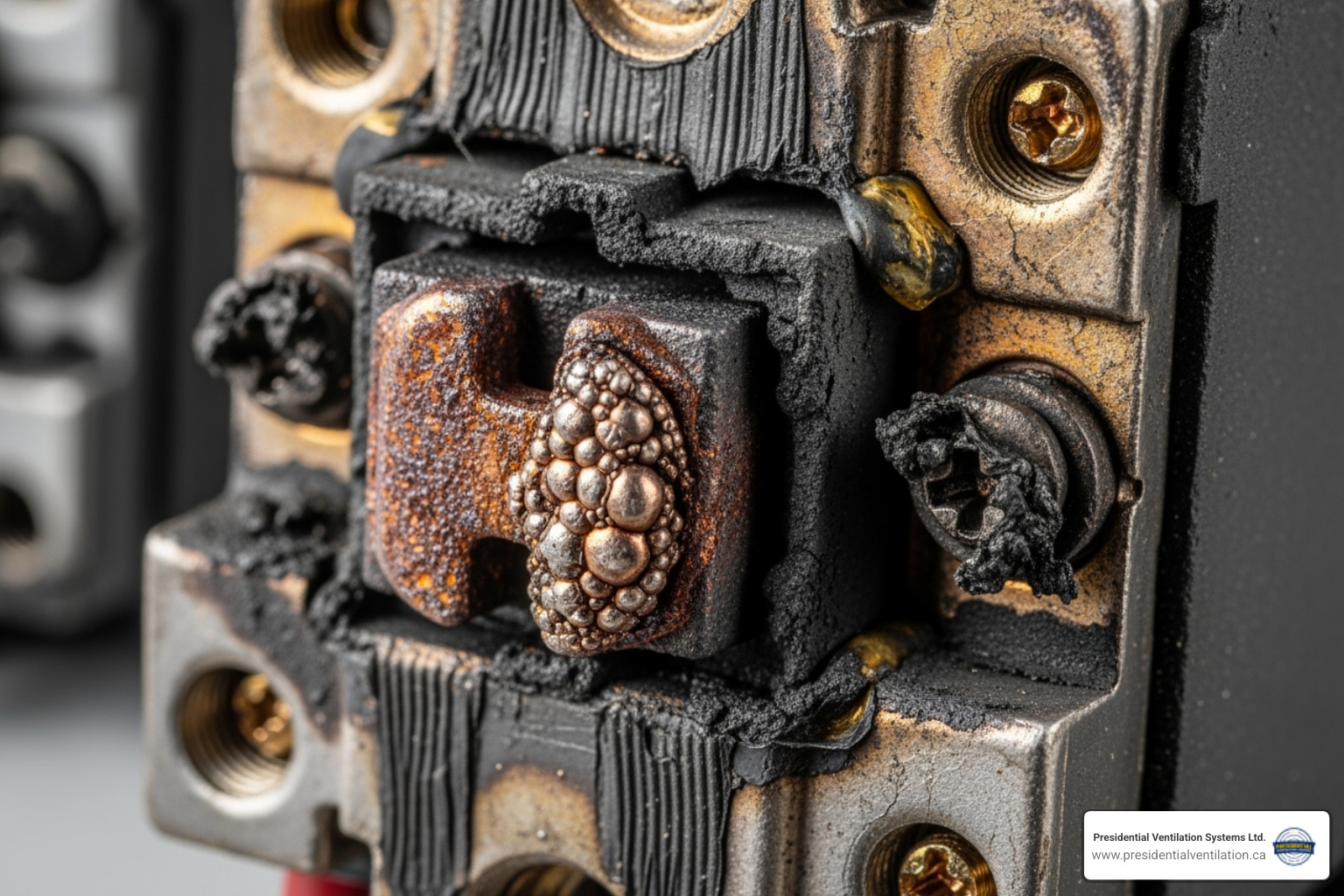
Visible damage is often the smoking gun. Inside the electrical panel, a failing contactor may have pitted and charred metal contacts from electrical arcing. You might also see corrosion, especially in our Maritime weather, or even melted plastic or burnt wires, which require immediate attention.
Don't ignore these warning signs. A failing contactor puts extra stress on your entire system and can eventually lead to compressor failure - one of the most expensive heat pump repairs you'll ever face. Regular maintenance helps catch these issues before they become major problems.
If you're experiencing any of these symptoms, you're likely looking at a contactor issue. For more insights into what might be affecting your heat pump's performance, check out our detailed guide on common heat pump issues.
For those who are comfortable with electrical work and keen to tackle home repairs, a heat pump contactor replacement can be a feasible DIY project. However, it's crucial to understand the risks and ensure you have the right knowledge and tools. We always advise caution, as working with high-voltage electricity is inherently dangerous.
Before you even think about picking up a screwdriver, there are some very important considerations for a DIY heat pump contactor replacement:
Understanding the fundamental role of this component is key to a successful repair. For a deeper dive into what a contactor is, you can check out this informative page: What is a Contactor?.
Having the right tools is essential for a safe and successful heat pump contactor replacement. Here's what we recommend you have on hand:
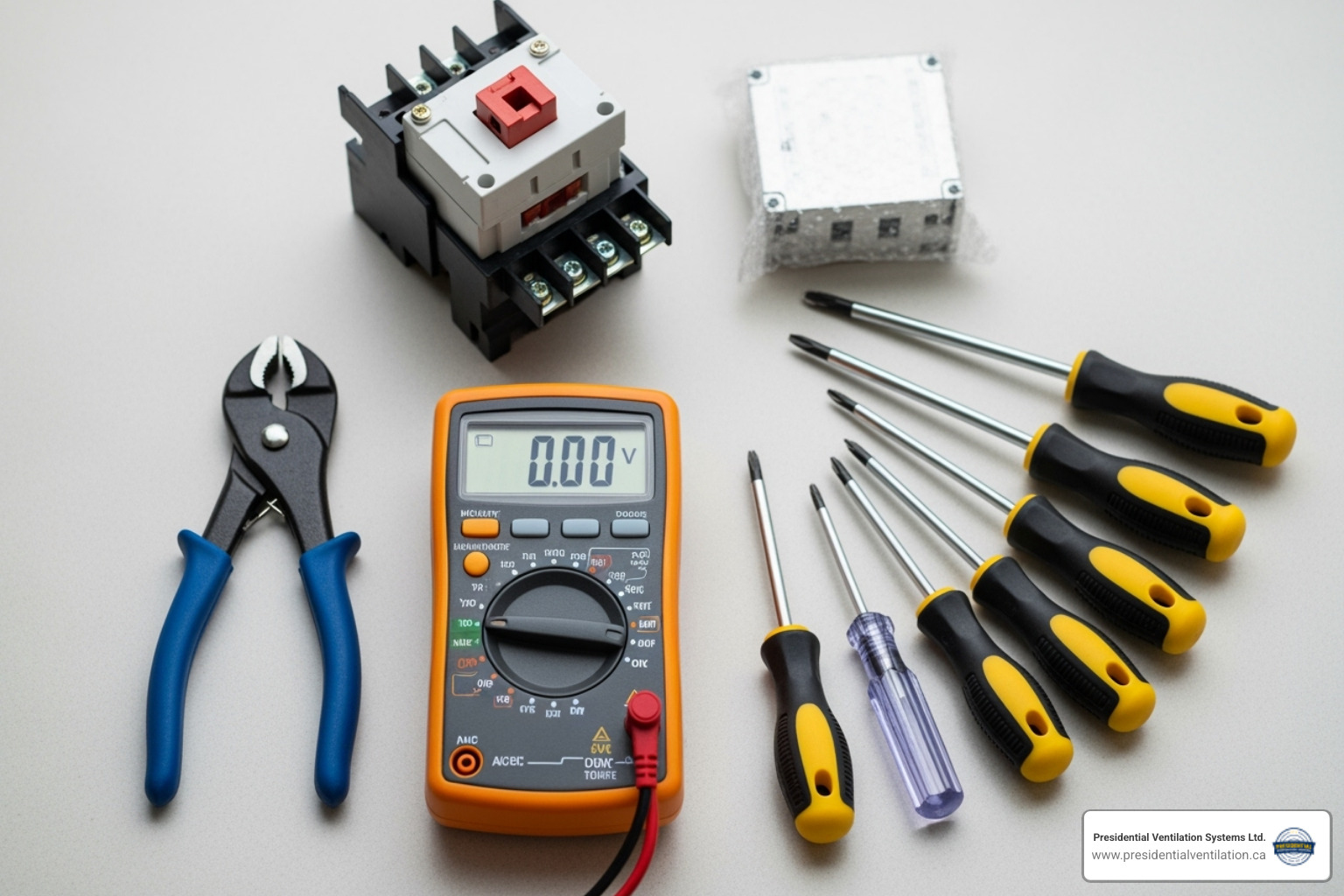
Selecting the correct replacement contactor is vital. Using the wrong one can lead to inefficiency, system damage, or even safety hazards.
Once you've gathered your tools and the correct replacement contactor, you're ready to begin the heat pump contactor replacement process. Safety is our top priority at Presidential Ventilation Systems Ltd., so follow these steps carefully.
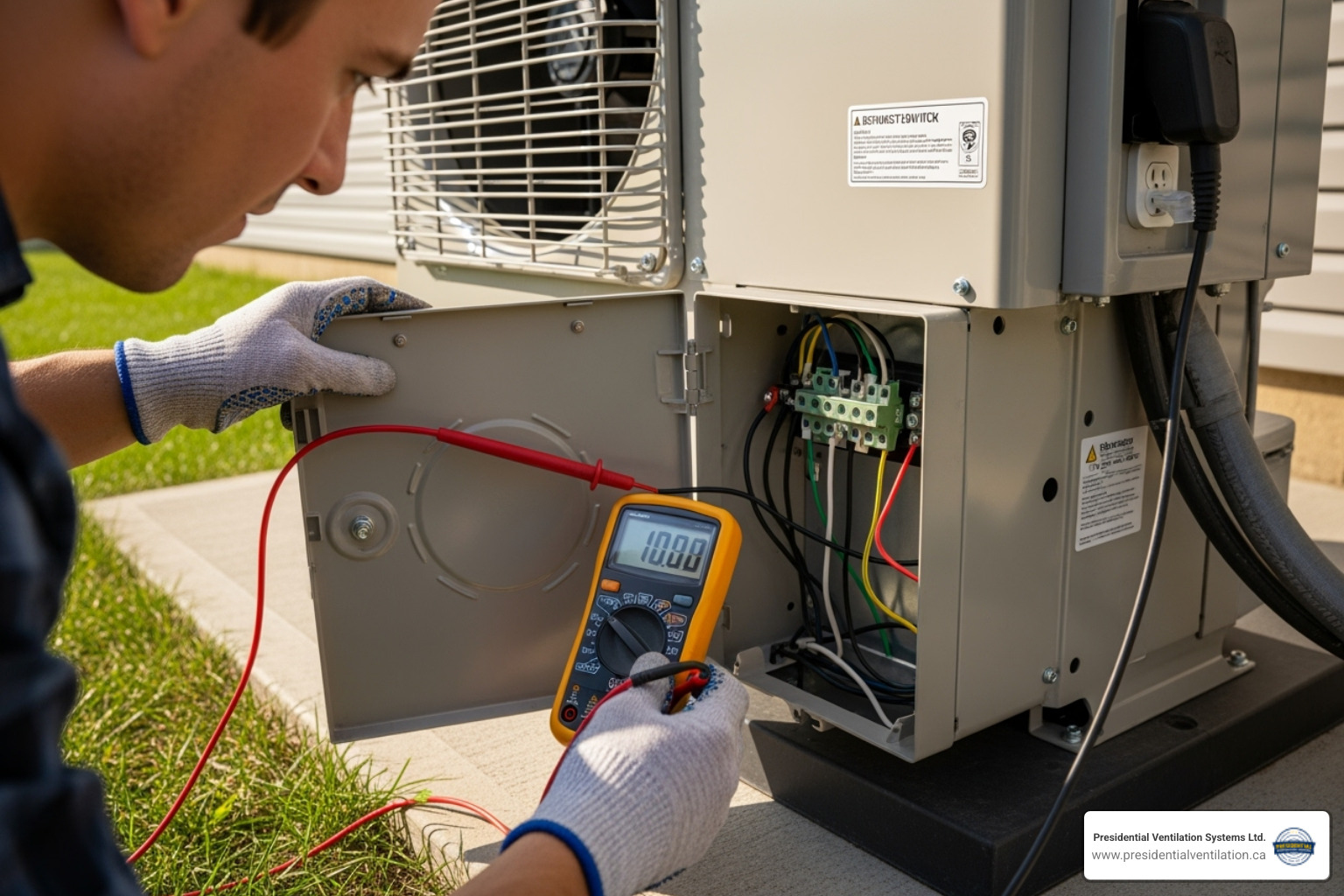
While this guide provides detailed steps, we understand that working with high voltage can be daunting. If you're ever in doubt, or prefer peace of mind, we're always here to help.
Sometimes the smartest move isn't always the DIY route. While we admire the spirit of homeowners who want to tackle repairs themselves, heat pump contactor replacement involves high-voltage electricity that demands respect and expertise. After three decades of serving families across Nova Scotia, we've learned that some repairs are simply better left to the professionals.
Here's a look at what you're getting into with a DIY approach versus calling in the experts:
| Feature | DIY Replacement | Professional Service |
|---|---|---|
| Cost | Parts only | Parts + labor |
| Time | 1 - 2 hours (experienced DIYer) | 30 minutes - 1 hour |
| Safety | High risk of electrical shock/fire | Minimal risk (trained, insured technician) |
| Warranty | May void heat pump warranty | Repair often warranted, original warranty preserved |
| Expertise | Requires significant electrical knowledge | Highly trained, certified HVAC technician |
| Diagnosis | Limited to obvious contactor issues | Thorough system diagnosis, identifies root causes |
| Tools | Requires specific, often expensive tools | Technician brings all specialized tools |
Electrical work is unforgiving. If you're not comfortable with high-voltage systems or using a multimeter, it's best to call a professional. Our licensed technicians have the training to do the job safely.
Professional help is essential when the problem is complex. What seems like a contactor failure could be a deeper issue with the capacitor, wiring, or compressor. A professional can diagnose the root cause, preventing repeat failures.
Warranty protection is a key factor. Many manufacturers require professional service to keep your warranty valid. A DIY repair could void it, costing you more in the long run.
Beyond the risk of shock, incorrect wiring can create fire hazards or damage expensive components like the compressor. Our insured technicians follow strict safety protocols to protect your home and equipment.
Professional diagnosis often saves money in the long run. We don't just swap parts – we investigate why the contactor failed in the first place. Maybe your system is short-cycling due to a refrigerant issue, or perhaps there's a voltage problem at your electrical panel. Addressing these underlying causes prevents repeated failures and keeps your system running efficiently.
The peace of mind that comes with professional service is hard to put a price on. Our technicians complete most contactor replacements quickly and efficiently, often in less than an hour. We test the entire system afterward to ensure everything is working correctly, and we stand behind our work with solid warranties.
We have teams ready to help across Nova Scotia, from Halifax and Dartmouth to Kentville, Truro, and everywhere in between. When your heat pump isn't cooperating, we're just a phone call away. Learn about our heat pump repair services and find why so many Nova Scotia families trust us to keep their homes comfortable year-round.
Over the years serving homeowners across Nova Scotia, we've noticed that certain questions about heat pump contactor replacement come up time and again. Whether you're dealing with a mysterious humming sound from your outdoor unit or wondering if that old contactor can soldier on for another season, these are the answers we find ourselves sharing most often.
The short answer is: replacement is almost always the better choice. While you can clean surface dirt, the real damage comes from electrical arcing. Each time the contactor operates, tiny arcs create pits and carbon buildup on the metal contacts. This damage is to the conductive material itself, not just surface grime, and prevents a solid electrical connection. Attempting to file or sand the contacts is a temporary fix at best. Given the low cost of a new contactor, replacement is the most reliable and effective solution.
Most heat pump contactors last 10 to 15 years, or about 100,000 cycles, under normal conditions. However, several factors can shorten this lifespan:
Regular maintenance is key to maximizing the contactor's lifespan. An annual inspection can catch early signs of wear before they cause a system failure.
Using a contactor that isn't an exact match for your system's specifications is risky and can lead to significant problems:
Always use a contactor with the correct pole, voltage, and amperage ratings to ensure safety, efficiency, and reliability. That's why we always take the time to match specifications exactly when we're doing repairs. The peace of mind and long-term reliability are worth getting it right the first time.
Your heat pump contactor might be a small component tucked away in your outdoor unit, but it's absolutely essential for keeping your home comfortable year-round. Think of it as the unsung hero of your heating and cooling system - quietly doing its job thousands of times each season to ensure your family stays warm in winter and cool in summer.
Throughout this guide, we've walked you through everything from recognizing the warning signs of a failing contactor to understanding your repair options. Whether you're hearing that telltale humming sound or your outdoor unit has stopped responding entirely, you now know what to look for and how to respond.
The choice between DIY and professional service ultimately comes down to your comfort level with electrical work and your priorities around safety and warranty protection. If you're handy with tools and comfortable working with high voltage, a heat pump contactor replacement can be a rewarding project that saves you some money. But remember - there's no shame in calling the professionals, especially when it comes to your family's safety and your system's reliability.
Correct installation is everything. A properly installed contactor ensures your compressor and condenser fan receive exactly the power they need, when they need it. This translates directly to better efficiency, lower energy bills, and a longer-lasting system. Get it wrong, and you could be looking at much more expensive repairs down the road.
Here's something we always tell our customers: proactive maintenance is your best friend. Annual inspections by qualified technicians can catch contactor issues before they leave you without heat on a frigid February morning or without cooling during a sweltering July afternoon. It's much easier (and cheaper) to replace a contactor during a routine service call than during an emergency repair.
At Presidential Ventilation Systems Ltd., we've been helping Nova Scotia families stay comfortable for over 30 years. As a leading Daikin Comfort Pro Dealer, our certified technicians have seen every type of contactor failure imaginable - and we know exactly how to fix them quickly and safely. We believe in doing the job right the first time, with long warranties and energy-saving solutions custom to your specific needs.
Don't let a faulty contactor disrupt your comfort or leave you wondering if your system will work when you need it most. Our team is ready to help, whether you need emergency repair or want to schedule preventive maintenance to avoid problems altogether.
Ready to get your heat pump running smoothly again? Schedule your professional heat pump repair in Halifax today and experience the peace of mind that comes with expert service.


Mini-split heat pump repair in lower sackville, ns is essential for maintaining year-round comfort in your home or business. When your system starts making strange noises, blowing weak air, or failing to heat or cool properly, you need a local expert who can diagnose and fix the problem quickly. Lower Sackville residents depend on these efficient systems to handle our Nova Scotia winters and summers, so any malfunction can disrupt your daily routine and spike your energy bills.
Quick Answer: Finding Mini-Split Repair Services in Lower Sackville
If your heat pump isn't keeping up with Nova Scotia's cold snaps or humid summers, you're likely dealing with one of several common issues that local technicians see regularly. According to industry data, heat pump systems tend to fail on the coldest days when you need them most, often because regular maintenance has been overlooked. The good news is that skilled local technicians have the tools and training to quickly identify problems and provide lasting solutions, whether it's a refrigerant leak, faulty sensor, or clogged drain line.
For comprehensive guidance on heat pump systems, check out our ductless heat pump services page, and when you're ready for expert repair, contact our certified team for prompt service.
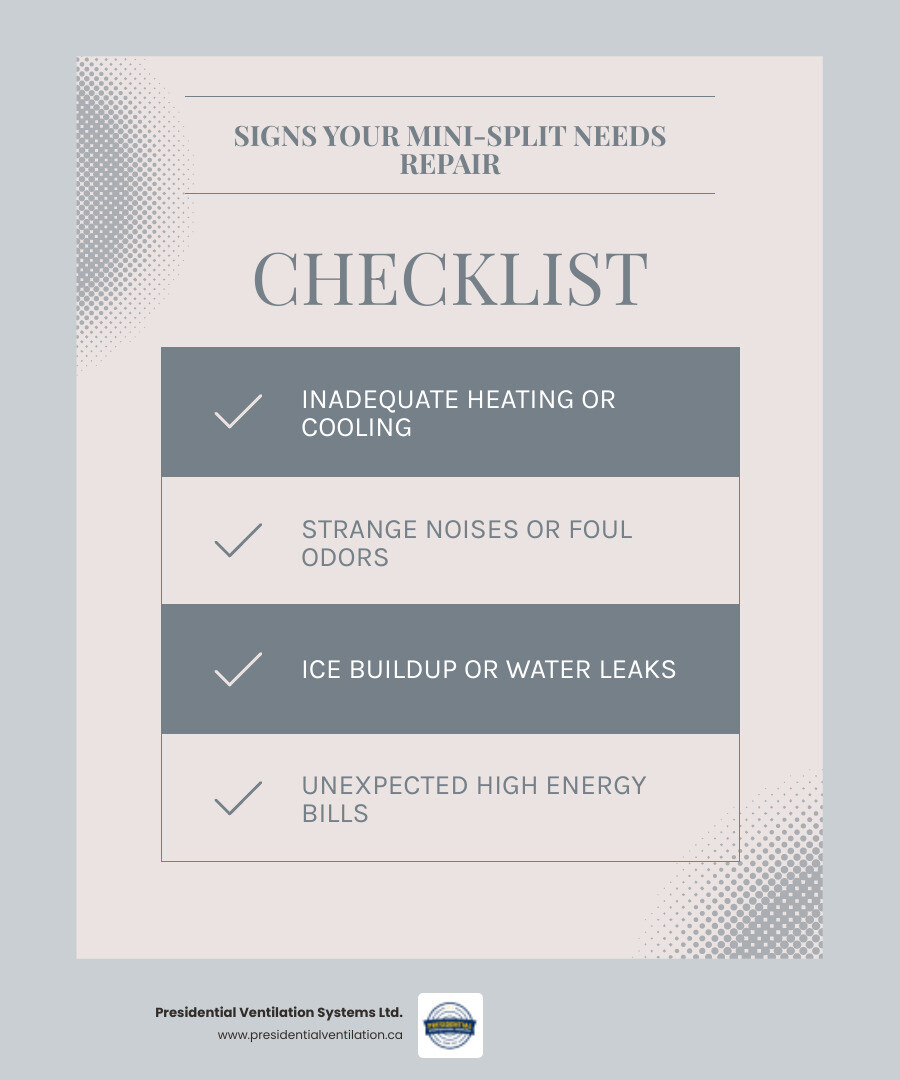
When your mini-split heat pump, a cornerstone of comfort in your Lower Sackville home, starts acting up, it's not just an inconvenience—it's a signal. Recognizing these signs early can save you from more extensive damage and costly repairs down the line. We understand how crucial these systems are for managing the fluctuating Nova Scotia climate, providing both warmth in winter and cooling in summer. Ignoring early warning signs can lead to a complete system breakdown, often at the most inconvenient times, like the coldest day of the year.
Our experience serving Halifax, Dartmouth, Lower Sackville, and surrounding areas has shown us that many issues could be resolved quickly if caught early. Here are some of the most common indicators that your mini-split heat pump repair in lower sackville, ns might be imminent:
When your heat pump starts to show any of these symptoms, call in the professionals. We service Upper, Middle, and Lower Sackville, and our technicians are well-versed in diagnosing and repairing these specific issues.
Our team is equipped to handle these and many other issues, ensuring your system is back to providing optimal comfort efficiently.
Mini-split heat pumps are sophisticated systems, and while they are generally reliable, various components can fail over time. When you need mini-split heat pump repair in lower sackville, ns, you need technicians who understand the intricacies of these units, from the refrigerant lines to the delicate electronic controls. Our skilled technicians have the expertise and tools to diagnose and resolve a wide array of problems, ensuring your system operates efficiently and effectively.
Here are some of the common issues we routinely repair:
No matter the issue, our team has the tools and expertise to quickly diagnose problems and provide long-lasting solutions, ensuring your comfort is restored.
When your mini-split heat pump falters, you want a repair process that is thorough, efficient, and transparent. For mini-split heat pump repair in lower sackville, ns, our approach is designed to get your system back up and running with minimal disruption to your home or business. We understand that a malfunctioning heat pump can be a major source of stress, especially during extreme weather.
Here's what our typical diagnostic and repair process entails:
We believe in clear communication and professional conduct from start to finish. When you schedule mini-split heat pump repair in lower sackville, ns with us, here’s what you can expect:
We service Upper, Middle, and Lower Sackville, and our commitment is to provide prompt, reliable, and expert service every time.
Finding a reliable company for mini-split heat pump repair in lower sackville, ns is crucial for ensuring the longevity and efficiency of your system. With many options available, knowing what factors to prioritize can make all the difference. We want our clients to trust us and depend on us for all of their home comfort needs, and we believe these considerations are key to making an informed decision.
Here’s what you should look for when choosing a repair service:
By prioritizing these factors, you can ensure that your mini-split heat pump repair in lower sackville, ns is handled by a reputable and skilled team, guaranteeing lasting comfort and efficiency for your home.
Preventative maintenance is not just a recommendation; it's a critical investment in the longevity and efficiency of your mini-split heat pump. For residents of Lower Sackville, where our climate demands consistent performance from heating and cooling systems, regular upkeep can make all the difference. Many heat pump failures, especially during the coldest days, could be avoided with proper maintenance.
Here’s why preventative maintenance is so important:
While professional maintenance is essential, there are also a few simple DIY tasks you can perform to help keep your mini-split in good shape:
While DIY tasks are helpful, professional maintenance goes much deeper, providing a thorough inspection and tune-up that only a professional technician can deliver. Our comprehensive maintenance plans are designed to maximize your mini-split's performance and lifespan.
During a professional maintenance visit, our technicians will perform several key tasks:
Regular professional maintenance by our team in Lower Sackville, Halifax, Dartmouth, and surrounding areas can significantly impact your mini-split heat pump’s efficiency and longevity. It ensures your system remains a reliable source of comfort for many years, helping you avoid unexpected breakdowns and costly emergency repairs.
Navigating mini-split heat pump repair in lower sackville, ns can seem daunting, but with the right knowledge and a trusted partner, maintaining your home's comfort is straightforward. We've explored the common signs that your mini-split needs attention, from strange noises and weak airflow to ice buildup and unexpected increases in energy bills. Recognizing these signals early is the first step toward effective resolution.
We've also detailed the types of issues our local technicians are equipped to handle, including intricate refrigerant leaks, electrical control failures, sensor problems, drainage issues, and fan motor malfunctions. Our professional diagnostic and repair process is designed to be thorough, transparent, and efficient, ensuring that you understand the problem and the solution every step of the way. With 24/7 emergency services available, we're always here when you need us most, because we understand that comfort can't wait.
Choosing a reliable repair company is paramount. Always prioritize local experience, technical expertise, positive customer reviews, proper insurance, and a steadfast commitment to quality service. These factors ensure that your repair is handled safely and effectively, giving you invaluable peace of mind.
Finally, we underscored the critical role of preventative maintenance. Regular tune-ups, coil cleaning, and electrical checks by skilled professionals not only improve your mini-split's efficiency and extend its lifespan but also help you avoid costly emergency repairs. A well-maintained system provides better air quality and consistent comfort, making it a wise investment for your Lower Sackville home.
For reliable mini-split heat pump repair in lower sackville, ns, trust our professional team to restore your home's comfort. With over 30 years of experience, Presidential Ventilation Systems Ltd. is your local expert for all residential and commercial HVAC needs, offering exceptional service and long-lasting solutions.


Heat pump maintenance Halifax services are crucial for keeping your system running efficiently in Nova Scotia's demanding climate. Homeowners in Halifax rely on heat pumps year-round, making proper care essential for comfort and savings.
Quick Answer for Heat Pump Maintenance Halifax:
Like a car, your heat pump needs regular tune-ups to run well. As one industry expert notes: "Regular maintenance on your home's HVAC system is as important as changing the oil in your car. The longer you go without it, the less life you'll get out of your system."
Halifax's coastal climate, with its salt air and humidity, puts extra stress on heat pump components. Without maintenance, dirt and mold build up, forcing your system to work harder and use more energy. A well-maintained heat pump saves money, provides consistent comfort, and improves indoor air quality by preventing allergens from circulating. This guide covers the top 10 maintenance facts to help you keep your system at its best.
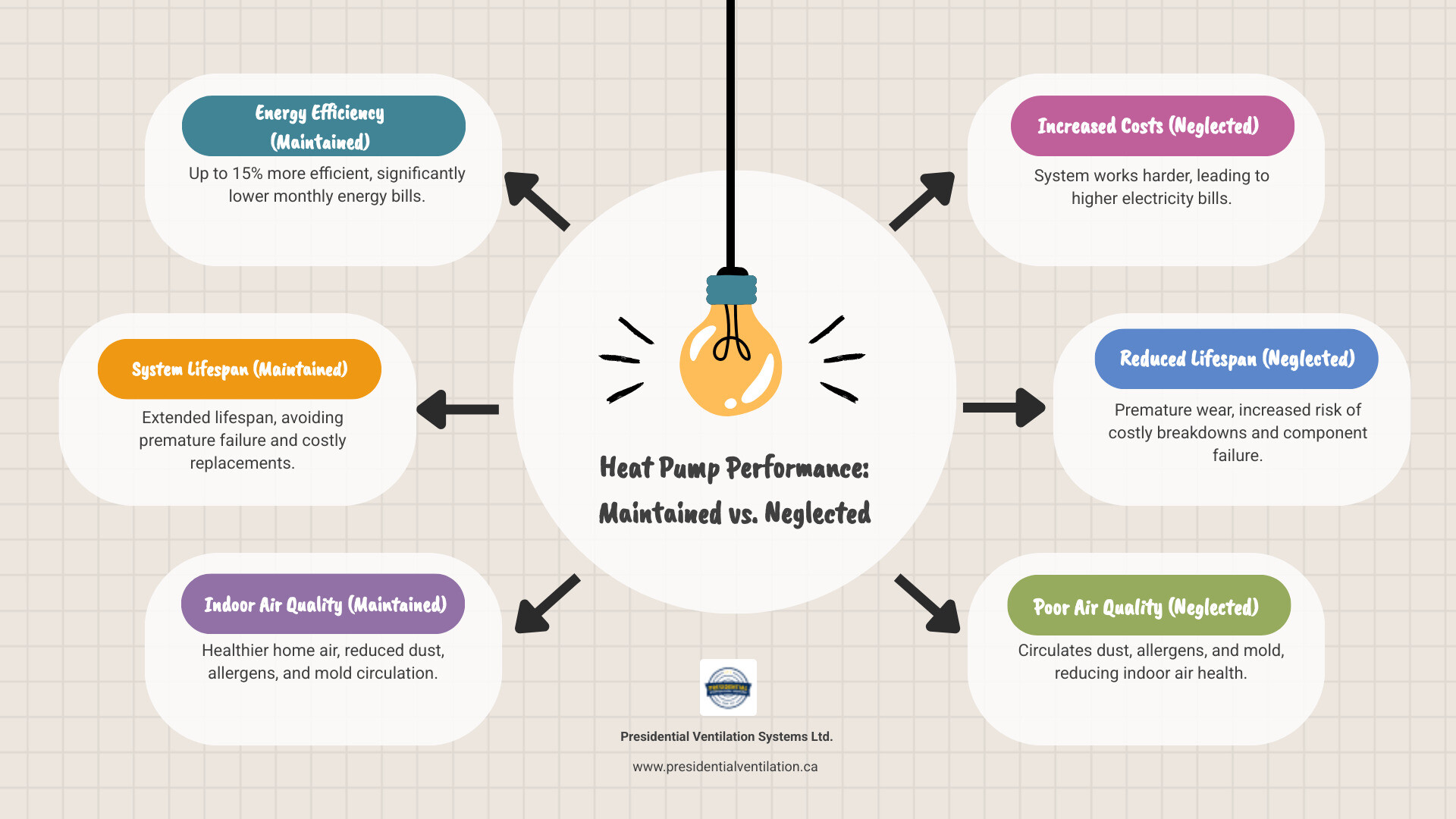
Heat pump maintenance halifax terms to remember:
Regular heat pump maintenance Halifax is your secret weapon against high energy costs. When your heat pump gets dirty, its efficiency plummets. Dirt and grime on your coils create an insulating barrier, preventing efficient heat transfer. When airflow gets reduced by clogged filters and dirty parts, the system works harder to move air, leading to increased energy consumption.
A neglected heat pump can lose up to 25% of its efficiency, causing higher electricity bills. As one expert states, "When your appliance's coil is unclean, it needs to work more to cool and heat the air."
Conversely, maximizing savings with a clean system restores peak performance. When our technicians clean the fans and coils, they restore your heat pump's ability to transfer heat efficiently. This means shorter run times and lower bills. The investment in professional heat pump maintenance Halifax pays for itself through significant energy savings.
Learn more about energy efficiencyMore info about Heat Pump Rebates Halifax NS
Regular heat pump maintenance Halifax is preventative care that protects your investment. Just like a car, your heat pump needs tune-ups to last. When dirt clogs coils and fans, the compressor—the heart of your system—works overtime to compensate.
This extra strain accelerates component wear and tear. The strain on the compressor and motors is especially concerning, as these are the most expensive parts to replace. Overheating can lead to "acid burnout," a catastrophic failure that may require replacing the entire outdoor unit.
The consequences of neglect include costly breakdowns and discomfort. Avoiding premature failure is key, as a system that should last 15-20 years might fail in half that time without proper care. We've seen many preventable breakdowns that leave families uncomfortable during Halifax's harsh winters. Annual maintenance catches small issues before they become major problems, extending your system's life and protecting your investment.
Read our Heat Pump Repair Halifax Ultimate Guide

Your heat pump constantly circulates air, so when it's dirty, so is the air you breathe. This makes heat pump maintenance Halifax vital for your family's health.
The dark, damp interior of a heat pump is an ideal breeding ground for mold and mildew growth. This can lead to microbial contamination of your home's air supply. Furthermore, allergens and dust accumulate on dirty coils and fans, which are then circulated throughout your living space. For those with allergies and asthma, this can make the home environment uncomfortable.
Regular heat pump maintenance Halifax service removes these airborne irritants at the source. Clean coils and fans promote healthier air circulation, meaning fewer allergens and cleaner air from your vents. Professional cleaning ensures your heat pump contributes to a healthier home, providing fresh, clean air for your family year-round.
Professional heat pump maintenance Halifax is a comprehensive health checkup for your system. Our service includes:
This detailed approach ensures every component receives the attention it needs, catching small issues before they become expensive problems.
More info about our Heat Pump Tune Up Halifax NS
While professional heat pump maintenance Halifax is essential, homeowners can perform simple tasks to maintain efficiency between visits.
These simple steps, combined with professional heat pump maintenance Halifax services, will keep your system running safely and efficiently.
Recognizing warning signs can help you avoid costly repairs. Call for service if you notice any of the following:
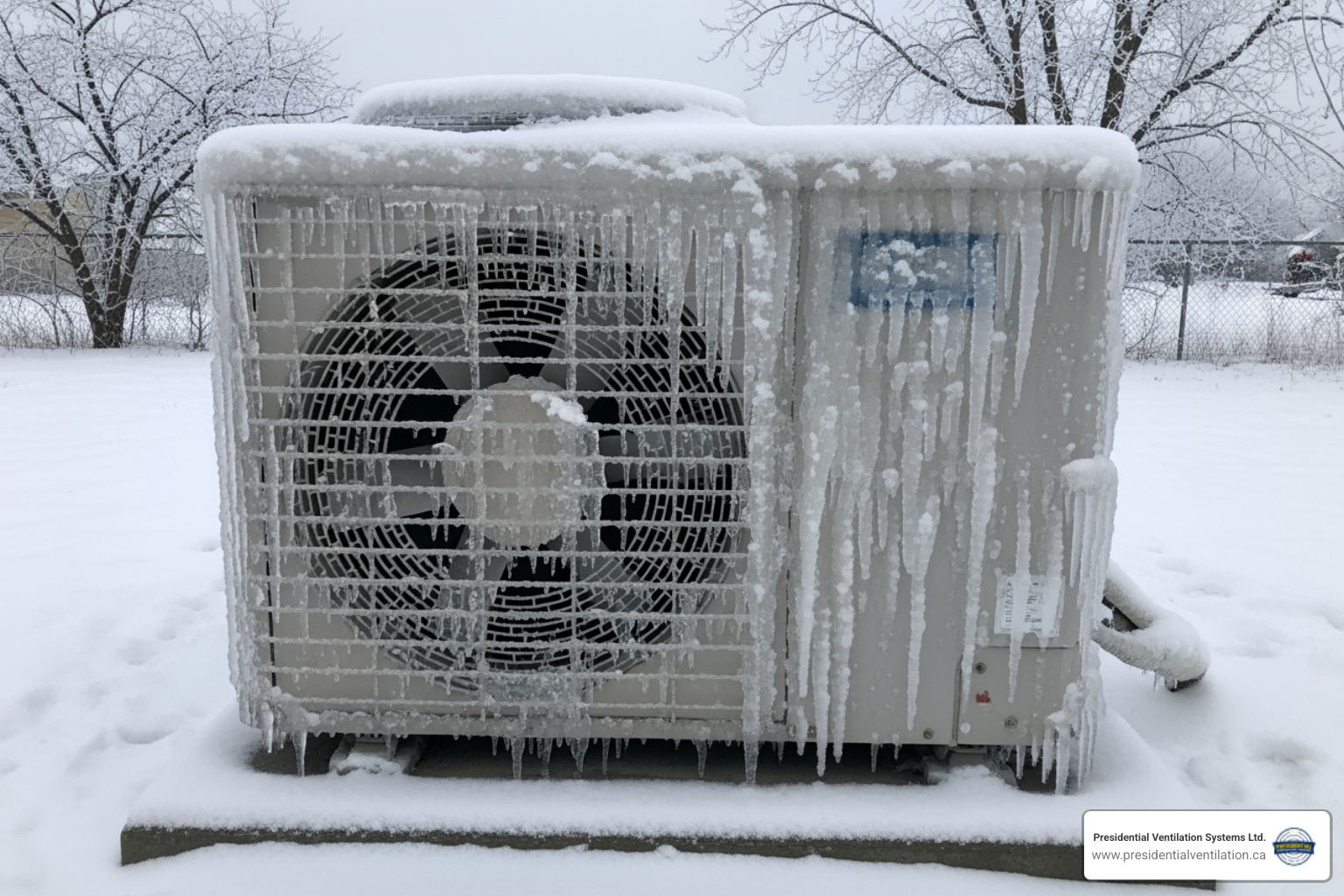
Acting promptly on these signs can prevent minor issues from becoming major breakdowns.
The timing of heat pump maintenance Halifax is critical due to our unique coastal climate. Annual service is essential for all Halifax homeowners to combat the stress placed on systems by Nova Scotia's weather.
Halifax's climate forces heat pumps to work hard year-round, from cold winters to humid summers. This constant operation leads to significant wear. The coastal environment adds another layer of complexity. Corrosive salt air accelerates wear on metal coils and components, while high humidity promotes mold growth inside the unit. Without proper care, these factors can shorten your system's lifespan.
We recommend pre-season tune-ups before winter and summer. A fall tune-up ensures your system is ready for peak heating demand, while a spring service prepares it for summer cooling. This proactive approach prevents unexpected failures during extreme weather, ensuring you're always prepared for Halifax's conditions.
Read our Annual Heat Pump Tune Up guide
Choosing the right professional for heat pump maintenance Halifax is crucial for your home's comfort and safety. Look for these key qualities:
At Presidential Ventilation Systems Ltd., we combine over 30 years of experience with brand-specific expertise. We know what it takes to keep systems running smoothly in our region, and we understand the consequences of cutting corners. Your comfort is too important to leave to chance.
Learn Why Daikin is a great choice
Annual maintenance plans transform heat pump maintenance Halifax from a chore into a predictable routine. Think of it as a subscription for your heat pump's health, ensuring it gets the professional attention it needs on a regular schedule.
The core benefits include:
An annual plan is an investment in consistent care that extends your system's life, maintains efficiency, and prevents surprise breakdowns.
More info about our Heat Pump Services Halifax NS
Putting off annual heat pump maintenance Halifax service can lead to shocking repair bills. By the time you notice a problem, significant damage may already be done. The consequences of neglect include:
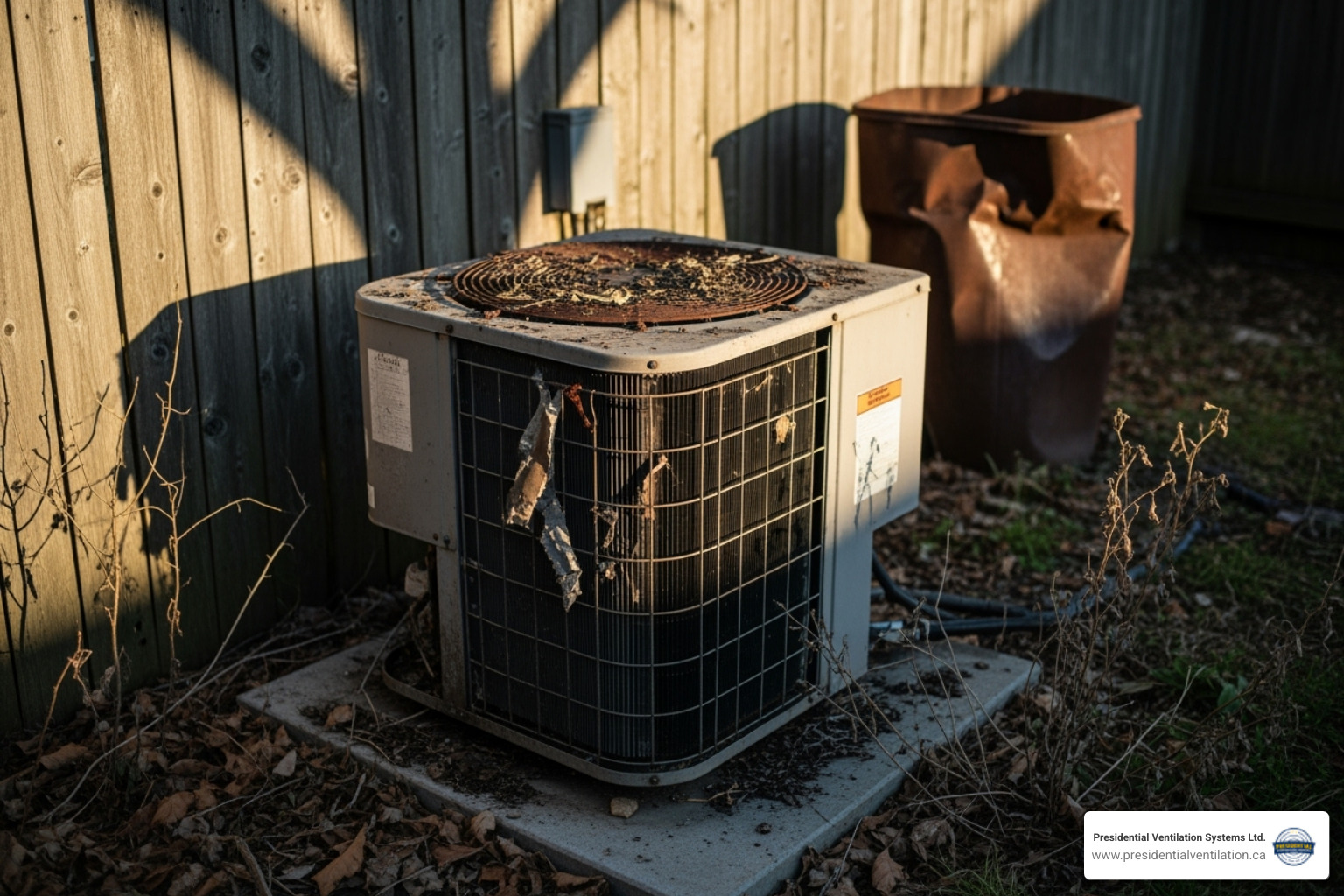
Skipping maintenance to save money today almost always leads to much larger expenses and safety concerns tomorrow.
Here are answers to common questions about heat pump maintenance from Halifax homeowners.
A professional service is a comprehensive check-up. It includes deep cleaning of indoor and outdoor coils, fan wheel, and chassis for maximum airflow and efficiency. We also inspect electrical and mechanical components, check refrigerant levels, clear the condensate drain, and run performance tests to ensure everything is working correctly and safely.
While homeowners should handle basic tasks like filter cleaning monthly and keeping the outdoor unit clear of debris, you should not attempt everything. Deep cleaning and technical inspections require a trained professional. Working with refrigerant and electrical components is dangerous without proper tools and training and could void your warranty. It's best to handle the simple tasks and leave the technical work to experts.
Halifax's salt air is corrosive and tough on your heat pump. It can accelerate deterioration of coils and metal components, especially on the outdoor unit. This buildup causes rust and reduces efficiency. That's why regular cleaning is essential to prevent damage in our coastal climate. Professional heat pump maintenance Halifax includes removing salt deposits to protect your system from these unique environmental challenges.
Investing in your heat pump is one of the smartest decisions for your Halifax home. This guide has shown why heat pump maintenance Halifax is a priority, not an afterthought. Regular maintenance lowers energy bills, extends your system's lifespan, and improves your home's air quality—real benefits for your comfort and wallet.
Halifax's coastal climate, with its salt air and demanding seasons, makes professional care even more critical. By combining simple DIY tasks with annual professional service, you can keep your system running at its best and avoid the costly consequences of neglect.
At Presidential Ventilation Systems Ltd., we have helped Halifax homeowners stay comfortable for over 30 years. As a proud Daikin Comfort Pro Dealer, we offer specialized expertise to ensure your heat pump thrives in our Maritime climate. Choose proactive care over reactive repairs.
Ready to give your heat pump the professional attention it deserves? Your future self—and your energy bills—will thank you.
Contact us for your professional Heat Pump Maintenance in Halifax NS